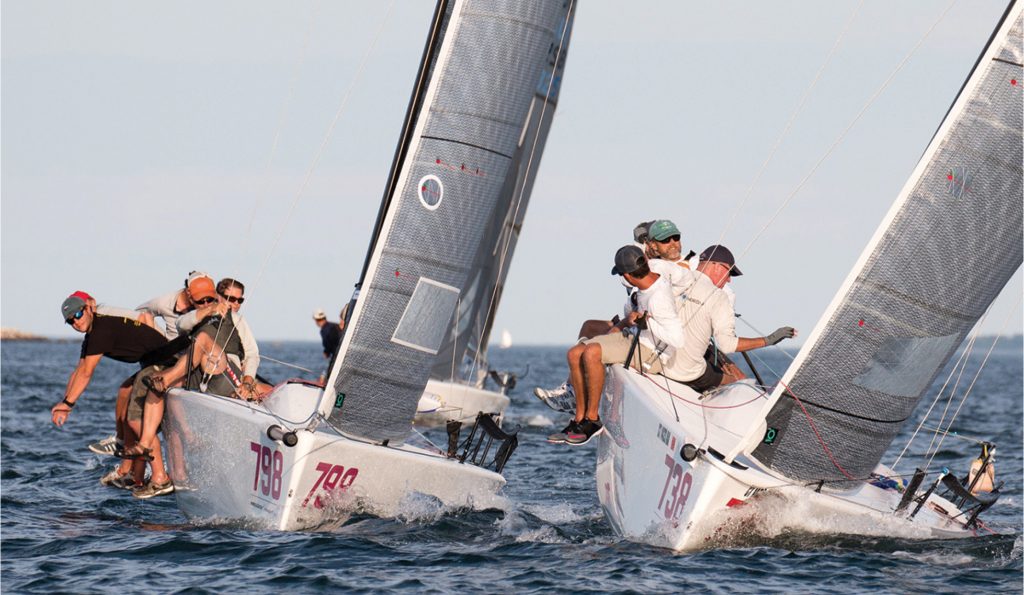By David Dellenbaugh
Strategy is your plan for how to get around the race course as quickly as you can. One problem is that strategy does not consider the presence of other boats. Since your competitors are all trying to win the race, too, they make it harder for you to follow your own gameplan. To overcome this you need good tactics.
Tactics are the boat-on-boat moves you make that help you stay in control of your race and follow your chosen strategy amidst a crowd of other boats. Using these moves effectively requires good boathandling skills and a confident knowledge of the rules.
While there are occasionally times when you use tactical moves to slow or beat one other boat (as in a match race), your tactics should almost always follow from your strategic plan, not vice versa. So keep your gameplan firmly in mind, and look ahead to anticipate any situations that might sidetrack you from that plan.
Tactics are obviously important in crowded areas of the course like the start or mark roundings, but they are also critical whenever you may be affected by even one other boat. On the second beat, for example, you wouldn’t want to let one boat force you to tack away from the favored side. Here are some tactical ideas to consider.

The second beat is late enough in the race to protect your position by covering the rest of the fleet, but usually still too early to focus only on one or two other boats (unless you’re near the windward mark). © Julia Cronin/Outrageous Photography
Cross, tack or duck?
Whenever you converge with a boat on the opposite tack, you have at least two major options. You can continue on your tack (by crossing or ducking the other boat) and keep going in the direction where you are headed. Or you can tack (either to leeward or in front of the other boat), and go the opposite direction.
If you fail to anticipate this situation, you might end up tacking because the other skipper yelled “Starboard” or because you didn’t want to give up any distance by ducking. But are those good reasons for heading toward the opposite side of the course? No.
The method you choose of deal- ing with the other boat should be consistent with your strategic plan. If you like the right side, for example, don’t tack. Instead, duck so you can stay on port tack. If you like the left side, you should tack.
Coordinating your tactics and strategy is especially important on the second beat for at least two reasons. First, this leg is relatively long, which makes strategy that much more important. If you don’t go the right way, you will give up a lot of leverage to boats that do.
Second, by the time you get to the second beat you are no longer tactically invisible like you were on the first beat. In other words, since boats are spread out more and you are closer to the finish, everyone is watching out for every other boat. If you don’t think ahead about your tactics versus other boats, you will lose control of your race and your ability to go where you want.
Tight or loose cover?
A basic tactical rule of thumb says, “Cover when you’re ahead and split when you’re behind.” This is usually good advice for the second beat. But when you’re ahead, how should you cover other boats?
The second beat is a transition period in this regard. Since strategy is still very important, you shouldn’t focus too much on other boats. But when you are doing well, you also don’t want to risk losing too many of the boats behind you. That’s why a loose cover on the fleet is probably the most useful tactic here.
The goal of a loose fleet cover is to stay between the bulk of the boats behind you and the windward mark. This way you stay in touch with these boats, but you can still generally follow your strategic plan. There are at least a couple of problems with using a tight cover on the second beat. First, this means you are probably too concerned with one other boat. And second, it forces that boat to tack and separate from you. Tight covers are usually better left to the shorter last beat, which is more tactical.
The last hundred yards
Tactics are important in the congestion around marks, so think ahead as you get closer to the windward mark. Because the boats are more spread out on the second beat, you can often approach the mark on port tack, a lot closer to the port layline than you would have tried on the first beat. Though other boats will have the right of way as they converge on starboard tack, by staying off the starboard layline you will avoid overstanding the mark, keep out of bad air, and maintain the ability to play windshifts. ■
This article originally appeared in David Dellenbaugh’s Speed & Smarts, The newsletter of how-to tips for racing sailors. If you want to sail faster and smarter, log onto SpeedandSmarts.com.
A resident of Easton, CT, Dellenbaugh was tactician and starting helmsman for America3’s successful defense of the America’s Cup in 1992. He’s a Lightning World Champion, two-time Congressional Cup winner, seven-time Thistle National Champion, two-time winner of the Canada’s Cup, three-time Prince of Wales U.S. Match Racing Champion, and a winner of the U.S. Team Racing Championships for the Hinman Trophy.



